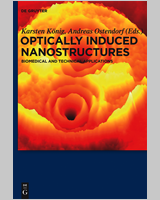This work is licensed under the Creative Commons Attribution-NonCommercial-NoDerivs 3.0 License.
Fig. 3.6From left to right: A time delayed pulse is frequency-doubled to 400 nm (blue pulses) and passes through a birefringent crystal (α-BBO 1). This creates a pair of orthogonally polarized pulses with a temporal separation of 6.5 ps. The reference and probe pulses propagate through the interaction area, together with the pump pulse (red pulse) in between, probing the changes in the optical properties. A second birefringent crystal (α-BBO 2) decreases the temporal separation between the blue pulses to 0.2 ps. After passing through a polarizer (P), the frequency-domain interference pattern is recorded in a spectrometer, containing the optical properties of the excited sample. An example (raw-data) for a pump pulse energy dependent scan is shown below
© 2015 N. Götte et al., published by De Gruyter.
- Fig. 3.6, From left to right: A time delayed pulse is frequency-doubled to 400 n...Fig. 3.6, From left to right: A time delayed pulse is frequency-doubled to 400 nm (blue pulses) and passes through a birefringent crystal (α-BBO 1). This creates a pair of orthogonally polarized pulses with a temporal separation of 6.5 ps. The reference and probe pulses propagate through the interaction area, together with the pump pulse (red pulse) in between, probing the changes in the optical properties. A second birefringent crystal (α-BBO 2) decreases the temporal separation between the blue pulses to 0.2 ps. After passing through a polarizer (P), the frequency-domain interference pattern is recorded in a spectrometer, containing the optical properties of the excited sample. An example (raw-data) for a pump pulse energy dependent scan is shown below - Optically Induced Nanostructures
Your browsing activity is empty.
Activity recording is turned off.
See more...

